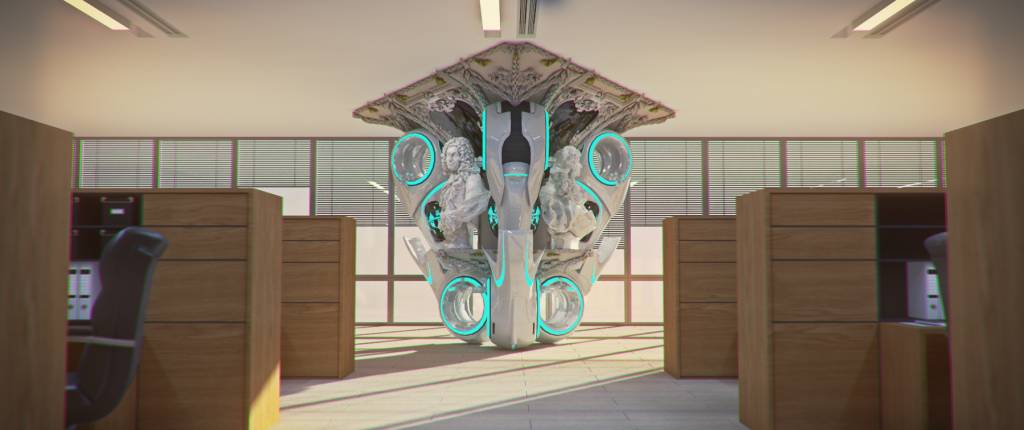Today we offer up a guest post by artist Jonathan Monaghan, whose video work, Rainbow Narcosis, is featured in State of the Art: Discovering American Art Now. You can view clips from the work here. –LD Playing video games as a child, I was always much more interested in exploring the created environments rather than playing the actual game. Although cinematic in composition, my work perhaps shares more with these video game environments than cinema. With my video installations, there is no film, no filming, no actors, few edits, no dialogue, and usually no specific beginning or end. Orchestrated in a virtual computer space, my works act more as windows into another world, another dimension, a kind of alternate reality. This world is fantastical and bizarre, but parallels our own, where imagery of power, wealth, and authority are conflated with consumerism, science fiction, ancient mythologies, and historical works of art. For example, Office combines historical and contemporary depictions of wealth and power. In the film, marble busts of Baroque-era aristocrats mounted on props from the cult science fiction film Tron explode in slow-motion within modern office cubicles.
My worlds are explored through a processional camera motion. In part this stems from the nature of the 3D computer software I use, which utilizes a virtual camera. The virtual camera can go anywhere and there is ease at which one can align animated movements with the path of the tacking shot. This affords me the ability to reveal different aspects of my world in a perfectly timed ballet of imagery, but it also separates the work from a format of cuts and edits pushing a narrative plot along. Instead the narrative unfolds through the absurd logic of my objects, environments, and creatures.
My first artistic interests were not traditional painters, sculptors, or even video artists, but video game designers and science fiction movies. I initially studied computer graphics with the intent to work in Hollywood, or make video games or commercials. It was in this arena that I established my aesthetic sensibility. But rather than pursuing a commercial, entertainment or technical career in 3D modeling, I became more interested in its ability to work in the analogical space of contemporary art, specifically in video art as well as sculpture through 3D printing.
Video artists such as Matthew Barney, with his visually imaginative films developed from a complex conceptual framework, encouraged this shift in my career. I felt my capabilities with the software allowed me to produce on a similar level, but without the large budgets. However I have consciously remained complicit in the process—and even imagery—of the commercial applications for computer graphics. From car commercials to architectural renderings, a slick, seductive, pristine sheen persists as a vehicle to unpack a subversive, political, yet still subjective exploration of power, value, and the role of technology.








